Unit 13 Report: Recruitment and Selection in Organizations
VerifiedAdded on 2020/06/06
|9
|2946
|37
Report
AI Summary
This report provides a comprehensive overview of recruitment and selection processes within organizations. It begins by exploring the planning of recruitment using both internal and external sources, highlighting the advantages and disadvantages of each approach. The report then delves into the impact of the legal and regulatory framework on recruitment activities, emphasizing key legislation like the Data Protection Act 1998 and the Sex Discrimination Act 1975/97. Furthermore, the report examines the various documents used in the selection and recruitment process, including person specifications, job descriptions, cover letters, application forms, and curriculum vitae. It also covers the planning and execution of selection interviews, outlining the processes for both employers and employees, and discusses different interview types, such as group and individual interviews. The report concludes by offering practical advice on how to take part in a selection interview, emphasizing the importance of preparation, professional conduct, and effective communication.
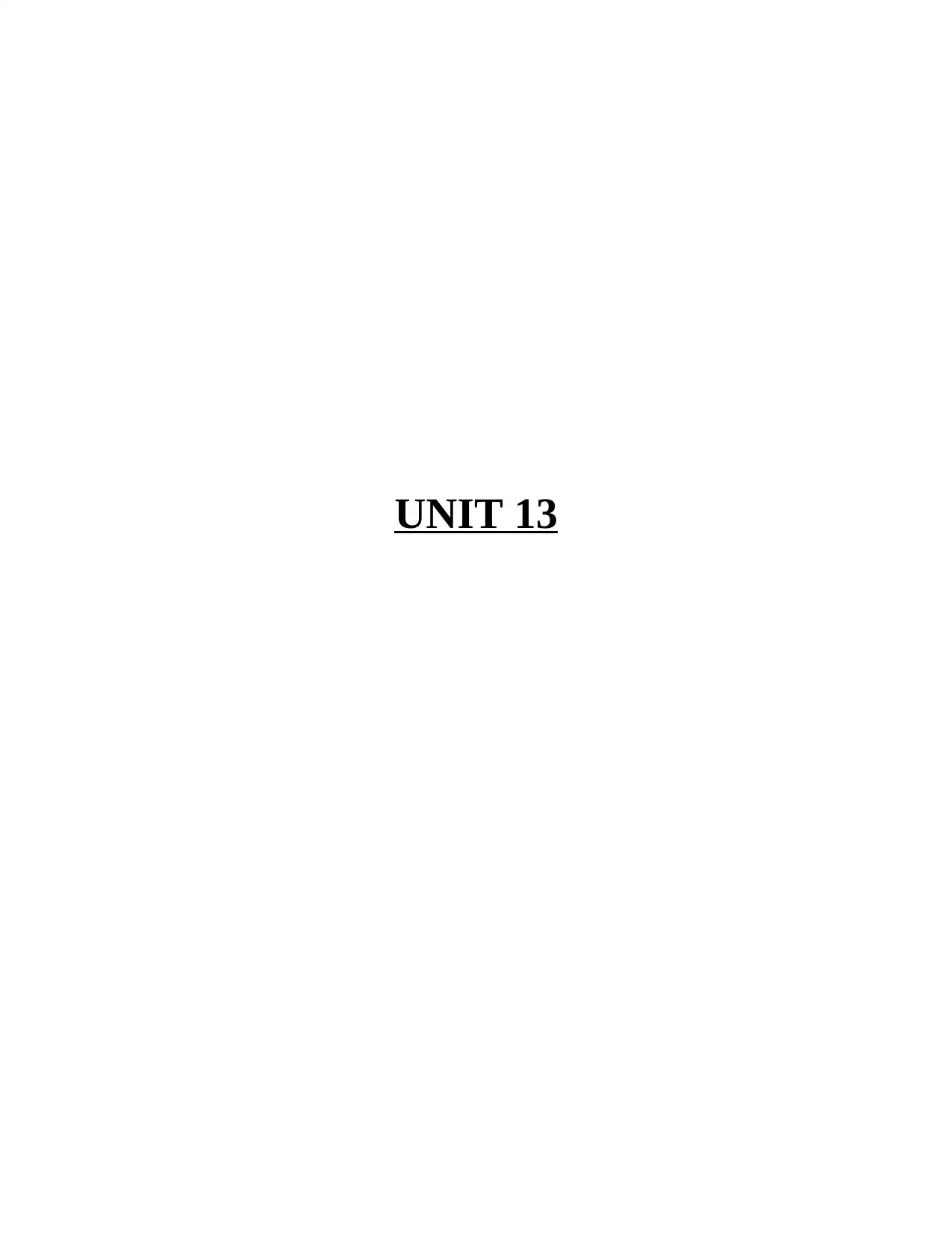
UNIT 13
Paraphrase This Document
Need a fresh take? Get an instant paraphrase of this document with our AI Paraphraser
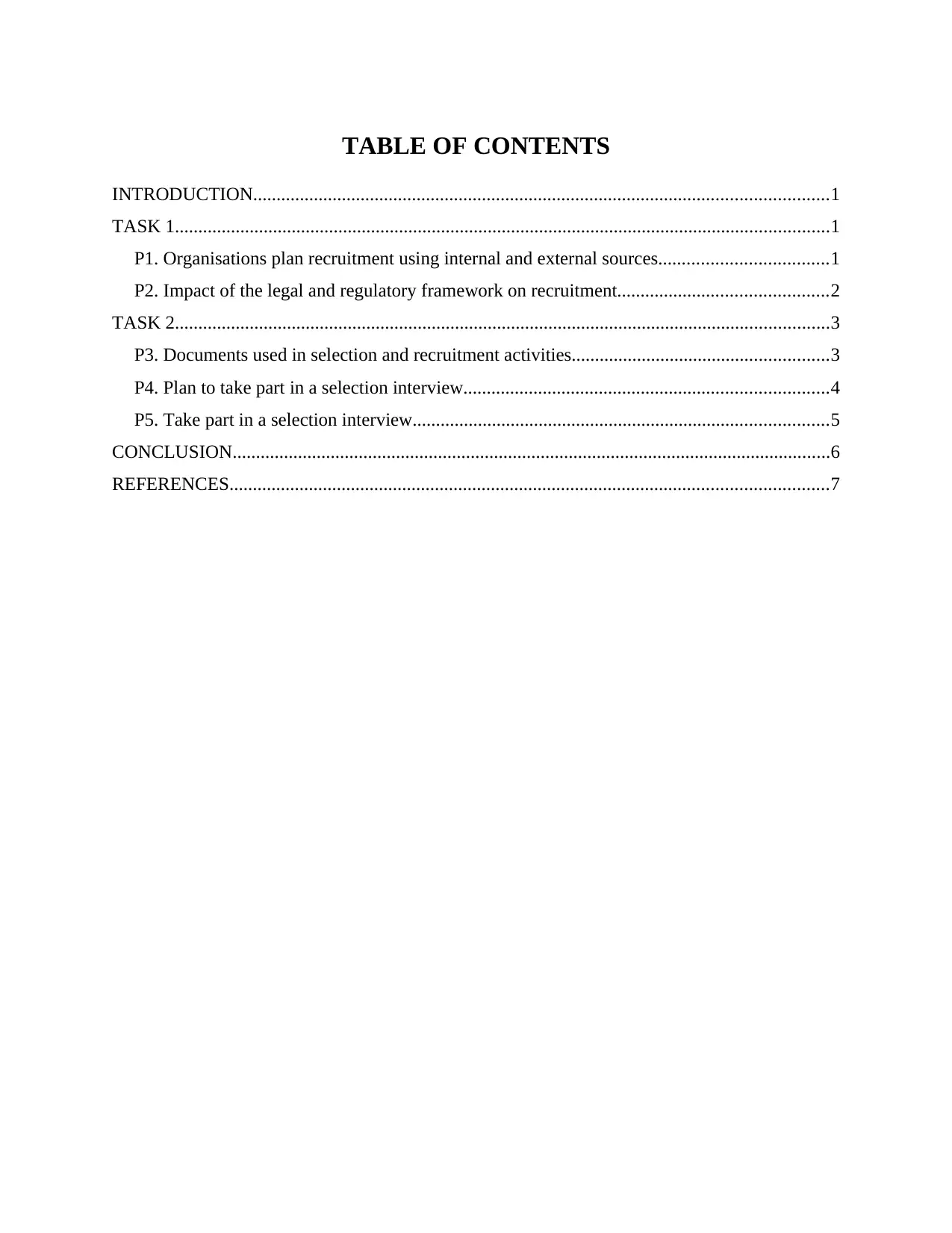
TABLE OF CONTENTS
INTRODUCTION...........................................................................................................................1
TASK 1............................................................................................................................................1
P1. Organisations plan recruitment using internal and external sources....................................1
P2. Impact of the legal and regulatory framework on recruitment.............................................2
TASK 2............................................................................................................................................3
P3. Documents used in selection and recruitment activities.......................................................3
P4. Plan to take part in a selection interview..............................................................................4
P5. Take part in a selection interview.........................................................................................5
CONCLUSION................................................................................................................................6
REFERENCES................................................................................................................................7
INTRODUCTION...........................................................................................................................1
TASK 1............................................................................................................................................1
P1. Organisations plan recruitment using internal and external sources....................................1
P2. Impact of the legal and regulatory framework on recruitment.............................................2
TASK 2............................................................................................................................................3
P3. Documents used in selection and recruitment activities.......................................................3
P4. Plan to take part in a selection interview..............................................................................4
P5. Take part in a selection interview.........................................................................................5
CONCLUSION................................................................................................................................6
REFERENCES................................................................................................................................7

INTRODUCTION
Recruiting the right people is the key to the success of many organisations. In this unit,
learners will develop an understanding of the impact of the regulatory framework on the
recruitment process. Potential applicants may decide to apply for a post based on the quality of
information that they receive (Kang and Shen, 2017). It is important that interviewers are well
organised and prepared. They will need to use effective communication and listening skills
during the interview. In this unit, learners will gain experience of the interview process through
taking part in an interview. Organisations with effective recruitment and selection processes and
practices in place are more likely to make successful staffing appointments.
TASK 1
P1. Organisations plan recruitment using internal and external sources
If the businesses expands they will need new employees to cover different areas or
machinery, a company may need to employ new people if existing staff go on
maternity/paternity leave or if someone leaves due to sickness, they would have to be replaced.
When a vacancy arises the business must discuss and plan how they will advertise for this,
whether they will advertise the vacancy internally or externally (Guedes, 2015). Internal
advertising is where a vacancy arises in a business and is given to an existing employee in the
company. Employees are informed about the vacancy by internal advertisements in the work
place. Another internal source which the business should consider when a vacancy arises is a
promotion; this is when an employee shifts to a different position which carries better prestige,
more responsibilities and higher pay.
If somebody in the business receives a promotion their present position will be vacant, if
employees see their colleagues get a promotion it will motivate them so they can do the same.
There are many methods of externally advertising for a job vacancy, for example informing
schools, colleges and universities about the vacancy so they can inform students or graduates
about jobs which they have the qualifications required for, this will lead to the best skilled people
applying for the job (Timming, 2015). Businesses could also inform job centres and recruitment
agencies about the vacancy they have, who could then propose the information to individuals
who have visited either a job centre or agency if the job role suits them, this will also mean a
wide range of people will apply for the job and therefore the business can analyse everyone’s
application and offer the job to the best. If a business is looking for a candidate externally they
1
Recruiting the right people is the key to the success of many organisations. In this unit,
learners will develop an understanding of the impact of the regulatory framework on the
recruitment process. Potential applicants may decide to apply for a post based on the quality of
information that they receive (Kang and Shen, 2017). It is important that interviewers are well
organised and prepared. They will need to use effective communication and listening skills
during the interview. In this unit, learners will gain experience of the interview process through
taking part in an interview. Organisations with effective recruitment and selection processes and
practices in place are more likely to make successful staffing appointments.
TASK 1
P1. Organisations plan recruitment using internal and external sources
If the businesses expands they will need new employees to cover different areas or
machinery, a company may need to employ new people if existing staff go on
maternity/paternity leave or if someone leaves due to sickness, they would have to be replaced.
When a vacancy arises the business must discuss and plan how they will advertise for this,
whether they will advertise the vacancy internally or externally (Guedes, 2015). Internal
advertising is where a vacancy arises in a business and is given to an existing employee in the
company. Employees are informed about the vacancy by internal advertisements in the work
place. Another internal source which the business should consider when a vacancy arises is a
promotion; this is when an employee shifts to a different position which carries better prestige,
more responsibilities and higher pay.
If somebody in the business receives a promotion their present position will be vacant, if
employees see their colleagues get a promotion it will motivate them so they can do the same.
There are many methods of externally advertising for a job vacancy, for example informing
schools, colleges and universities about the vacancy so they can inform students or graduates
about jobs which they have the qualifications required for, this will lead to the best skilled people
applying for the job (Timming, 2015). Businesses could also inform job centres and recruitment
agencies about the vacancy they have, who could then propose the information to individuals
who have visited either a job centre or agency if the job role suits them, this will also mean a
wide range of people will apply for the job and therefore the business can analyse everyone’s
application and offer the job to the best. If a business is looking for a candidate externally they
1
⊘ This is a preview!⊘
Do you want full access?
Subscribe today to unlock all pages.

Trusted by 1+ million students worldwide

will advertise to the public, the company will firstly need to decide what form of media to use,
for example TV advert, radio, newspaper, flyers or billboard, they could also advertise on an
online job vacancy websites (Armstrong, Landers and Collmus, 2016). Large companies could
afford to spend a lot to broadcast their vacancy on radio adverts in order to reach the largest
audience possible, whereas this would not be an option for a business.
P2. Impact of the legal and regulatory framework on recruitment
There are various laws which may affect recruitment and selection activities in a business
which include both legal and ethical factors. There are a number of legal issues presently in
favour of the public and businesses have to ensure that these laws are respected during their
activities (Almeida and Fernando, 2017). If employers are found breaching these laws, they
could risk heavy penalties. Businesses have to comply with the law to uphold customer trust, be
seen as compliant and avoid potential ‘embargo’ on the business.
Legal Issues:
The Data Protection Act 1998
The Data Protection Act 1998 laws on the processing of data on identifiable living people
and it is one of the main legislations which govern the protection of personal data in the UK.
Businesses should consider this law and take the appropriate measures to ensure that personal
data provided by applicants during recruitment and selection processes are only used for lawful
purposes and kept only for matters relevant to employment. In addition to this, all the
information obtained should be confidentially and securely maintained (Klotz and et.al., 2013).
Employees must not disclose any candidate details and businesses should make sure that they do
not possess these personal details for longer than necessary. If an organisation is found to be in
breach of the Data Protection Act 1998, this can incur possible loss of business and brand
damage. The business could also be subject to penalties from the UK Information
Commissioner’s Once. Amongst its powers, the ICO can prosecute and issue finances of up to
£500,000 and undertake proceedings that can lead to prison sentences.
The Sex Discrimination Act 1975/97
The Sex discrimination act 1975/97 states that employees should be protected from any
sort of discrimination based on their gender or sexuality under the Equality Act 2010. To comply
with this law, employers must ensure that recruitment and selection processes are free from
discrimination and treat both men and women equally (Stanujkic, Djordjevic and Karabasevic,
2
for example TV advert, radio, newspaper, flyers or billboard, they could also advertise on an
online job vacancy websites (Armstrong, Landers and Collmus, 2016). Large companies could
afford to spend a lot to broadcast their vacancy on radio adverts in order to reach the largest
audience possible, whereas this would not be an option for a business.
P2. Impact of the legal and regulatory framework on recruitment
There are various laws which may affect recruitment and selection activities in a business
which include both legal and ethical factors. There are a number of legal issues presently in
favour of the public and businesses have to ensure that these laws are respected during their
activities (Almeida and Fernando, 2017). If employers are found breaching these laws, they
could risk heavy penalties. Businesses have to comply with the law to uphold customer trust, be
seen as compliant and avoid potential ‘embargo’ on the business.
Legal Issues:
The Data Protection Act 1998
The Data Protection Act 1998 laws on the processing of data on identifiable living people
and it is one of the main legislations which govern the protection of personal data in the UK.
Businesses should consider this law and take the appropriate measures to ensure that personal
data provided by applicants during recruitment and selection processes are only used for lawful
purposes and kept only for matters relevant to employment. In addition to this, all the
information obtained should be confidentially and securely maintained (Klotz and et.al., 2013).
Employees must not disclose any candidate details and businesses should make sure that they do
not possess these personal details for longer than necessary. If an organisation is found to be in
breach of the Data Protection Act 1998, this can incur possible loss of business and brand
damage. The business could also be subject to penalties from the UK Information
Commissioner’s Once. Amongst its powers, the ICO can prosecute and issue finances of up to
£500,000 and undertake proceedings that can lead to prison sentences.
The Sex Discrimination Act 1975/97
The Sex discrimination act 1975/97 states that employees should be protected from any
sort of discrimination based on their gender or sexuality under the Equality Act 2010. To comply
with this law, employers must ensure that recruitment and selection processes are free from
discrimination and treat both men and women equally (Stanujkic, Djordjevic and Karabasevic,
2
Paraphrase This Document
Need a fresh take? Get an instant paraphrase of this document with our AI Paraphraser
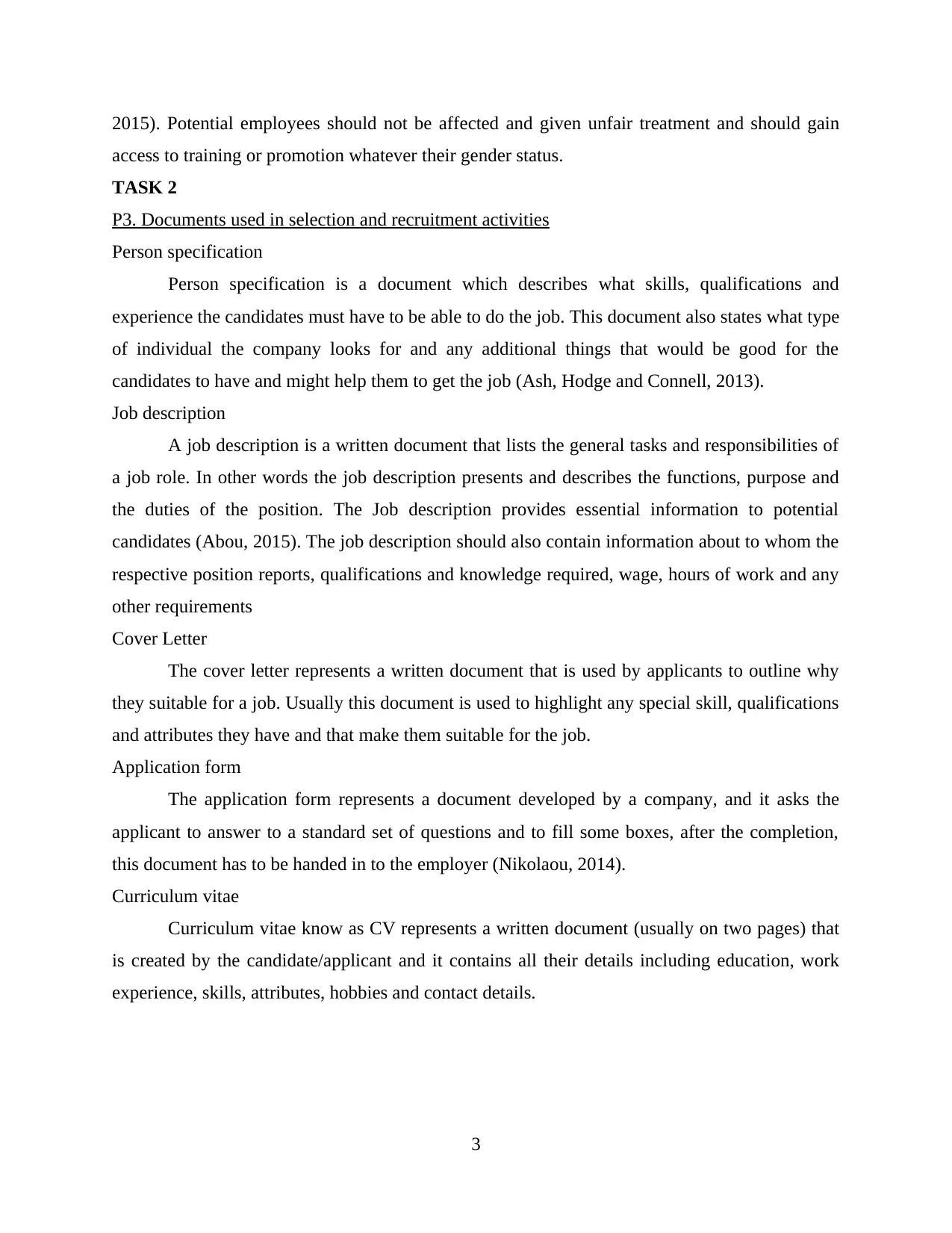
2015). Potential employees should not be affected and given unfair treatment and should gain
access to training or promotion whatever their gender status.
TASK 2
P3. Documents used in selection and recruitment activities
Person specification
Person specification is a document which describes what skills, qualifications and
experience the candidates must have to be able to do the job. This document also states what type
of individual the company looks for and any additional things that would be good for the
candidates to have and might help them to get the job (Ash, Hodge and Connell, 2013).
Job description
A job description is a written document that lists the general tasks and responsibilities of
a job role. In other words the job description presents and describes the functions, purpose and
the duties of the position. The Job description provides essential information to potential
candidates (Abou, 2015). The job description should also contain information about to whom the
respective position reports, qualifications and knowledge required, wage, hours of work and any
other requirements
Cover Letter
The cover letter represents a written document that is used by applicants to outline why
they suitable for a job. Usually this document is used to highlight any special skill, qualifications
and attributes they have and that make them suitable for the job.
Application form
The application form represents a document developed by a company, and it asks the
applicant to answer to a standard set of questions and to fill some boxes, after the completion,
this document has to be handed in to the employer (Nikolaou, 2014).
Curriculum vitae
Curriculum vitae know as CV represents a written document (usually on two pages) that
is created by the candidate/applicant and it contains all their details including education, work
experience, skills, attributes, hobbies and contact details.
3
access to training or promotion whatever their gender status.
TASK 2
P3. Documents used in selection and recruitment activities
Person specification
Person specification is a document which describes what skills, qualifications and
experience the candidates must have to be able to do the job. This document also states what type
of individual the company looks for and any additional things that would be good for the
candidates to have and might help them to get the job (Ash, Hodge and Connell, 2013).
Job description
A job description is a written document that lists the general tasks and responsibilities of
a job role. In other words the job description presents and describes the functions, purpose and
the duties of the position. The Job description provides essential information to potential
candidates (Abou, 2015). The job description should also contain information about to whom the
respective position reports, qualifications and knowledge required, wage, hours of work and any
other requirements
Cover Letter
The cover letter represents a written document that is used by applicants to outline why
they suitable for a job. Usually this document is used to highlight any special skill, qualifications
and attributes they have and that make them suitable for the job.
Application form
The application form represents a document developed by a company, and it asks the
applicant to answer to a standard set of questions and to fill some boxes, after the completion,
this document has to be handed in to the employer (Nikolaou, 2014).
Curriculum vitae
Curriculum vitae know as CV represents a written document (usually on two pages) that
is created by the candidate/applicant and it contains all their details including education, work
experience, skills, attributes, hobbies and contact details.
3
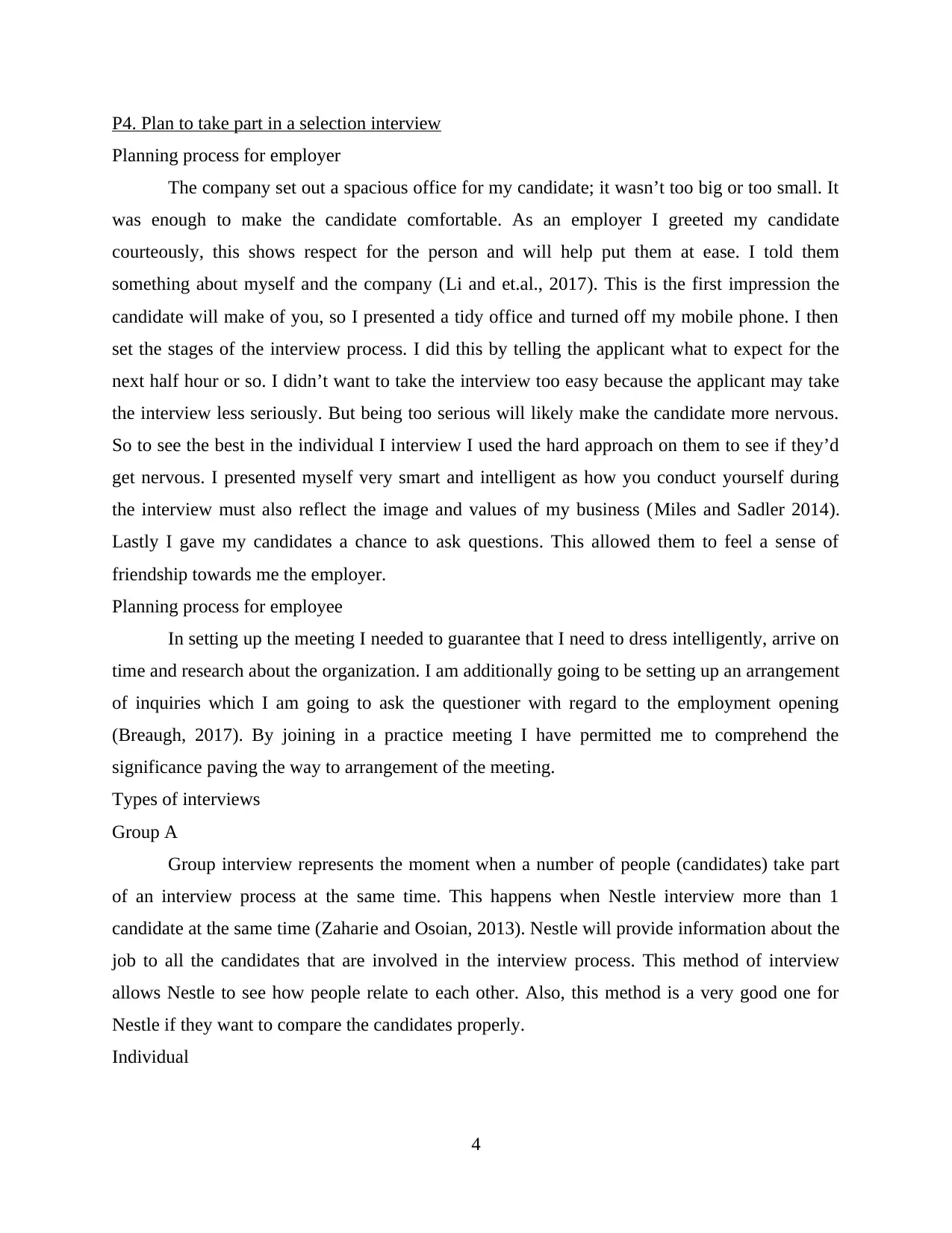
P4. Plan to take part in a selection interview
Planning process for employer
The company set out a spacious office for my candidate; it wasn’t too big or too small. It
was enough to make the candidate comfortable. As an employer I greeted my candidate
courteously, this shows respect for the person and will help put them at ease. I told them
something about myself and the company (Li and et.al., 2017). This is the first impression the
candidate will make of you, so I presented a tidy office and turned off my mobile phone. I then
set the stages of the interview process. I did this by telling the applicant what to expect for the
next half hour or so. I didn’t want to take the interview too easy because the applicant may take
the interview less seriously. But being too serious will likely make the candidate more nervous.
So to see the best in the individual I interview I used the hard approach on them to see if they’d
get nervous. I presented myself very smart and intelligent as how you conduct yourself during
the interview must also reflect the image and values of my business (Miles and Sadler 2014).
Lastly I gave my candidates a chance to ask questions. This allowed them to feel a sense of
friendship towards me the employer.
Planning process for employee
In setting up the meeting I needed to guarantee that I need to dress intelligently, arrive on
time and research about the organization. I am additionally going to be setting up an arrangement
of inquiries which I am going to ask the questioner with regard to the employment opening
(Breaugh, 2017). By joining in a practice meeting I have permitted me to comprehend the
significance paving the way to arrangement of the meeting.
Types of interviews
Group A
Group interview represents the moment when a number of people (candidates) take part
of an interview process at the same time. This happens when Nestle interview more than 1
candidate at the same time (Zaharie and Osoian, 2013). Nestle will provide information about the
job to all the candidates that are involved in the interview process. This method of interview
allows Nestle to see how people relate to each other. Also, this method is a very good one for
Nestle if they want to compare the candidates properly.
Individual
4
Planning process for employer
The company set out a spacious office for my candidate; it wasn’t too big or too small. It
was enough to make the candidate comfortable. As an employer I greeted my candidate
courteously, this shows respect for the person and will help put them at ease. I told them
something about myself and the company (Li and et.al., 2017). This is the first impression the
candidate will make of you, so I presented a tidy office and turned off my mobile phone. I then
set the stages of the interview process. I did this by telling the applicant what to expect for the
next half hour or so. I didn’t want to take the interview too easy because the applicant may take
the interview less seriously. But being too serious will likely make the candidate more nervous.
So to see the best in the individual I interview I used the hard approach on them to see if they’d
get nervous. I presented myself very smart and intelligent as how you conduct yourself during
the interview must also reflect the image and values of my business (Miles and Sadler 2014).
Lastly I gave my candidates a chance to ask questions. This allowed them to feel a sense of
friendship towards me the employer.
Planning process for employee
In setting up the meeting I needed to guarantee that I need to dress intelligently, arrive on
time and research about the organization. I am additionally going to be setting up an arrangement
of inquiries which I am going to ask the questioner with regard to the employment opening
(Breaugh, 2017). By joining in a practice meeting I have permitted me to comprehend the
significance paving the way to arrangement of the meeting.
Types of interviews
Group A
Group interview represents the moment when a number of people (candidates) take part
of an interview process at the same time. This happens when Nestle interview more than 1
candidate at the same time (Zaharie and Osoian, 2013). Nestle will provide information about the
job to all the candidates that are involved in the interview process. This method of interview
allows Nestle to see how people relate to each other. Also, this method is a very good one for
Nestle if they want to compare the candidates properly.
Individual
4
⊘ This is a preview!⊘
Do you want full access?
Subscribe today to unlock all pages.

Trusted by 1+ million students worldwide
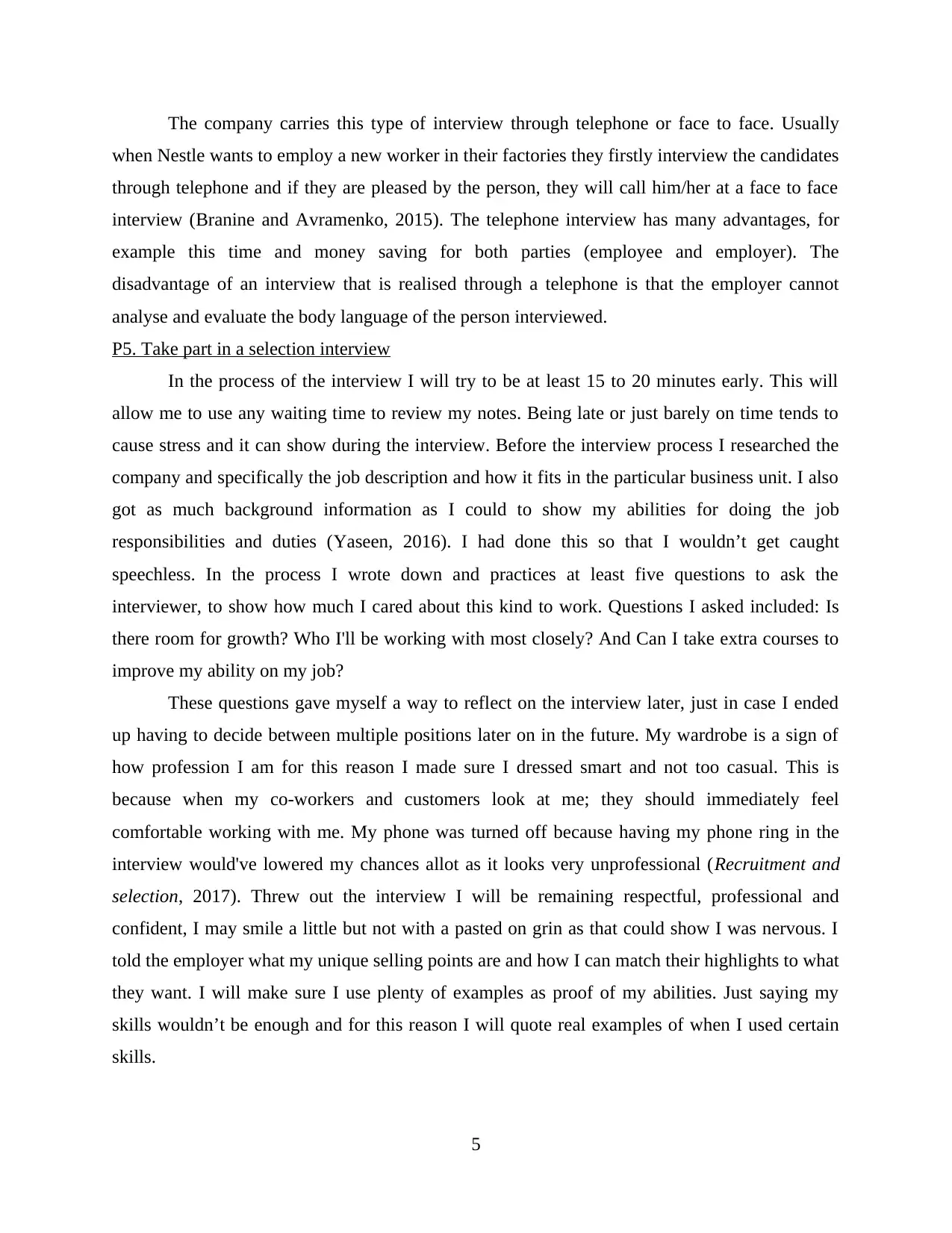
The company carries this type of interview through telephone or face to face. Usually
when Nestle wants to employ a new worker in their factories they firstly interview the candidates
through telephone and if they are pleased by the person, they will call him/her at a face to face
interview (Branine and Avramenko, 2015). The telephone interview has many advantages, for
example this time and money saving for both parties (employee and employer). The
disadvantage of an interview that is realised through a telephone is that the employer cannot
analyse and evaluate the body language of the person interviewed.
P5. Take part in a selection interview
In the process of the interview I will try to be at least 15 to 20 minutes early. This will
allow me to use any waiting time to review my notes. Being late or just barely on time tends to
cause stress and it can show during the interview. Before the interview process I researched the
company and specifically the job description and how it fits in the particular business unit. I also
got as much background information as I could to show my abilities for doing the job
responsibilities and duties (Yaseen, 2016). I had done this so that I wouldn’t get caught
speechless. In the process I wrote down and practices at least five questions to ask the
interviewer, to show how much I cared about this kind to work. Questions I asked included: Is
there room for growth? Who I'll be working with most closely? And Can I take extra courses to
improve my ability on my job?
These questions gave myself a way to reflect on the interview later, just in case I ended
up having to decide between multiple positions later on in the future. My wardrobe is a sign of
how profession I am for this reason I made sure I dressed smart and not too casual. This is
because when my co-workers and customers look at me; they should immediately feel
comfortable working with me. My phone was turned off because having my phone ring in the
interview would've lowered my chances allot as it looks very unprofessional (Recruitment and
selection, 2017). Threw out the interview I will be remaining respectful, professional and
confident, I may smile a little but not with a pasted on grin as that could show I was nervous. I
told the employer what my unique selling points are and how I can match their highlights to what
they want. I will make sure I use plenty of examples as proof of my abilities. Just saying my
skills wouldn’t be enough and for this reason I will quote real examples of when I used certain
skills.
5
when Nestle wants to employ a new worker in their factories they firstly interview the candidates
through telephone and if they are pleased by the person, they will call him/her at a face to face
interview (Branine and Avramenko, 2015). The telephone interview has many advantages, for
example this time and money saving for both parties (employee and employer). The
disadvantage of an interview that is realised through a telephone is that the employer cannot
analyse and evaluate the body language of the person interviewed.
P5. Take part in a selection interview
In the process of the interview I will try to be at least 15 to 20 minutes early. This will
allow me to use any waiting time to review my notes. Being late or just barely on time tends to
cause stress and it can show during the interview. Before the interview process I researched the
company and specifically the job description and how it fits in the particular business unit. I also
got as much background information as I could to show my abilities for doing the job
responsibilities and duties (Yaseen, 2016). I had done this so that I wouldn’t get caught
speechless. In the process I wrote down and practices at least five questions to ask the
interviewer, to show how much I cared about this kind to work. Questions I asked included: Is
there room for growth? Who I'll be working with most closely? And Can I take extra courses to
improve my ability on my job?
These questions gave myself a way to reflect on the interview later, just in case I ended
up having to decide between multiple positions later on in the future. My wardrobe is a sign of
how profession I am for this reason I made sure I dressed smart and not too casual. This is
because when my co-workers and customers look at me; they should immediately feel
comfortable working with me. My phone was turned off because having my phone ring in the
interview would've lowered my chances allot as it looks very unprofessional (Recruitment and
selection, 2017). Threw out the interview I will be remaining respectful, professional and
confident, I may smile a little but not with a pasted on grin as that could show I was nervous. I
told the employer what my unique selling points are and how I can match their highlights to what
they want. I will make sure I use plenty of examples as proof of my abilities. Just saying my
skills wouldn’t be enough and for this reason I will quote real examples of when I used certain
skills.
5
Paraphrase This Document
Need a fresh take? Get an instant paraphrase of this document with our AI Paraphraser

CONCLUSION
From this report, it has been concluded that communication skills are very essential for
selecting any employee. The company may look for the attitude and behaviour of the candidate
to assess his personality. Further, it has been concluded that legal rules and regulatory laws will
have major influence on the selection of the candidate.
6
From this report, it has been concluded that communication skills are very essential for
selecting any employee. The company may look for the attitude and behaviour of the candidate
to assess his personality. Further, it has been concluded that legal rules and regulatory laws will
have major influence on the selection of the candidate.
6
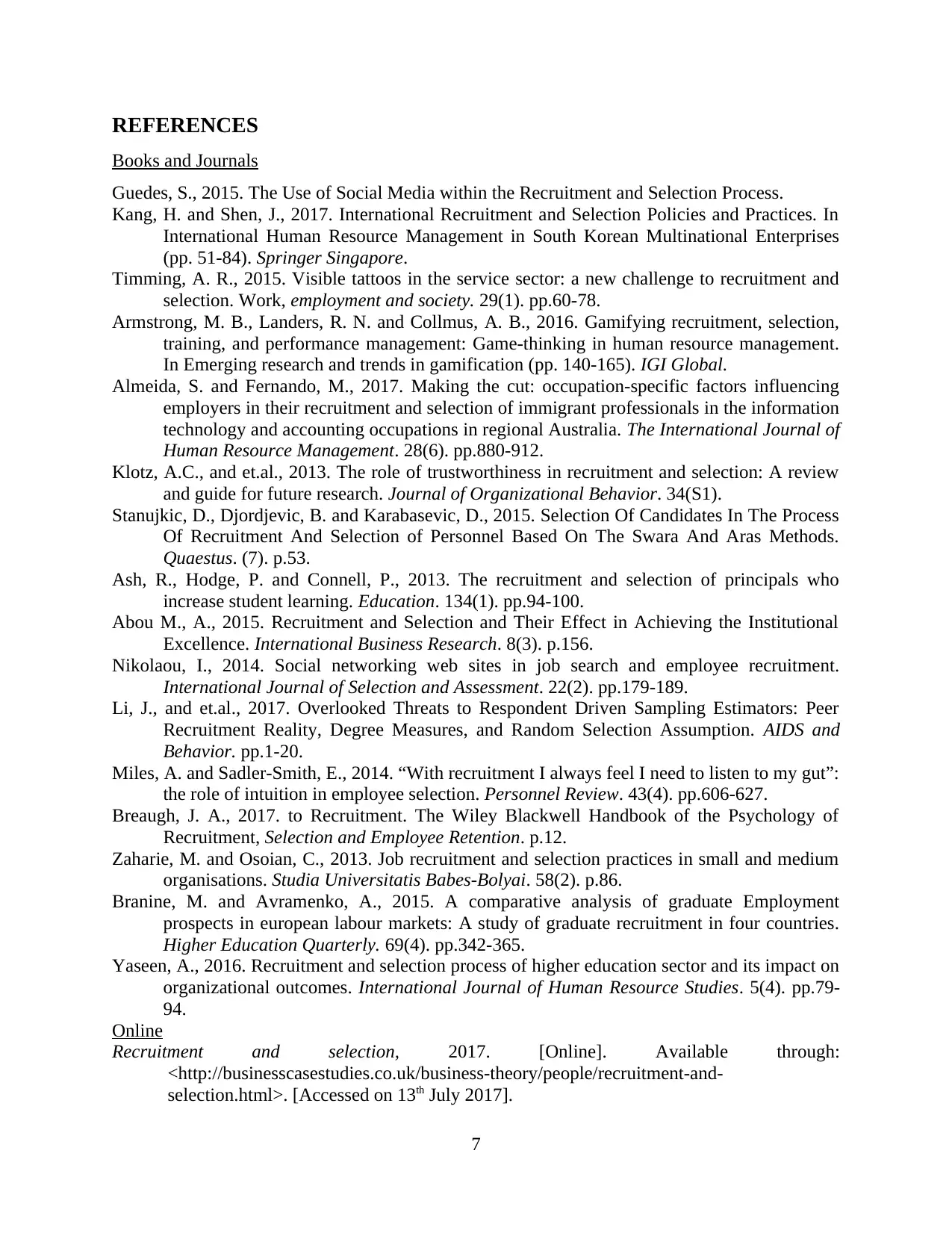
REFERENCES
Books and Journals
Guedes, S., 2015. The Use of Social Media within the Recruitment and Selection Process.
Kang, H. and Shen, J., 2017. International Recruitment and Selection Policies and Practices. In
International Human Resource Management in South Korean Multinational Enterprises
(pp. 51-84). Springer Singapore.
Timming, A. R., 2015. Visible tattoos in the service sector: a new challenge to recruitment and
selection. Work, employment and society. 29(1). pp.60-78.
Armstrong, M. B., Landers, R. N. and Collmus, A. B., 2016. Gamifying recruitment, selection,
training, and performance management: Game-thinking in human resource management.
In Emerging research and trends in gamification (pp. 140-165). IGI Global.
Almeida, S. and Fernando, M., 2017. Making the cut: occupation-specific factors influencing
employers in their recruitment and selection of immigrant professionals in the information
technology and accounting occupations in regional Australia. The International Journal of
Human Resource Management. 28(6). pp.880-912.
Klotz, A.C., and et.al., 2013. The role of trustworthiness in recruitment and selection: A review
and guide for future research. Journal of Organizational Behavior. 34(S1).
Stanujkic, D., Djordjevic, B. and Karabasevic, D., 2015. Selection Of Candidates In The Process
Of Recruitment And Selection of Personnel Based On The Swara And Aras Methods.
Quaestus. (7). p.53.
Ash, R., Hodge, P. and Connell, P., 2013. The recruitment and selection of principals who
increase student learning. Education. 134(1). pp.94-100.
Abou M., A., 2015. Recruitment and Selection and Their Effect in Achieving the Institutional
Excellence. International Business Research. 8(3). p.156.
Nikolaou, I., 2014. Social networking web sites in job search and employee recruitment.
International Journal of Selection and Assessment. 22(2). pp.179-189.
Li, J., and et.al., 2017. Overlooked Threats to Respondent Driven Sampling Estimators: Peer
Recruitment Reality, Degree Measures, and Random Selection Assumption. AIDS and
Behavior. pp.1-20.
Miles, A. and Sadler-Smith, E., 2014. “With recruitment I always feel I need to listen to my gut”:
the role of intuition in employee selection. Personnel Review. 43(4). pp.606-627.
Breaugh, J. A., 2017. to Recruitment. The Wiley Blackwell Handbook of the Psychology of
Recruitment, Selection and Employee Retention. p.12.
Zaharie, M. and Osoian, C., 2013. Job recruitment and selection practices in small and medium
organisations. Studia Universitatis Babes-Bolyai. 58(2). p.86.
Branine, M. and Avramenko, A., 2015. A comparative analysis of graduate Employment
prospects in european labour markets: A study of graduate recruitment in four countries.
Higher Education Quarterly. 69(4). pp.342-365.
Yaseen, A., 2016. Recruitment and selection process of higher education sector and its impact on
organizational outcomes. International Journal of Human Resource Studies. 5(4). pp.79-
94.
Online
Recruitment and selection, 2017. [Online]. Available through:
<http://businesscasestudies.co.uk/business-theory/people/recruitment-and-
selection.html>. [Accessed on 13th July 2017].
7
Books and Journals
Guedes, S., 2015. The Use of Social Media within the Recruitment and Selection Process.
Kang, H. and Shen, J., 2017. International Recruitment and Selection Policies and Practices. In
International Human Resource Management in South Korean Multinational Enterprises
(pp. 51-84). Springer Singapore.
Timming, A. R., 2015. Visible tattoos in the service sector: a new challenge to recruitment and
selection. Work, employment and society. 29(1). pp.60-78.
Armstrong, M. B., Landers, R. N. and Collmus, A. B., 2016. Gamifying recruitment, selection,
training, and performance management: Game-thinking in human resource management.
In Emerging research and trends in gamification (pp. 140-165). IGI Global.
Almeida, S. and Fernando, M., 2017. Making the cut: occupation-specific factors influencing
employers in their recruitment and selection of immigrant professionals in the information
technology and accounting occupations in regional Australia. The International Journal of
Human Resource Management. 28(6). pp.880-912.
Klotz, A.C., and et.al., 2013. The role of trustworthiness in recruitment and selection: A review
and guide for future research. Journal of Organizational Behavior. 34(S1).
Stanujkic, D., Djordjevic, B. and Karabasevic, D., 2015. Selection Of Candidates In The Process
Of Recruitment And Selection of Personnel Based On The Swara And Aras Methods.
Quaestus. (7). p.53.
Ash, R., Hodge, P. and Connell, P., 2013. The recruitment and selection of principals who
increase student learning. Education. 134(1). pp.94-100.
Abou M., A., 2015. Recruitment and Selection and Their Effect in Achieving the Institutional
Excellence. International Business Research. 8(3). p.156.
Nikolaou, I., 2014. Social networking web sites in job search and employee recruitment.
International Journal of Selection and Assessment. 22(2). pp.179-189.
Li, J., and et.al., 2017. Overlooked Threats to Respondent Driven Sampling Estimators: Peer
Recruitment Reality, Degree Measures, and Random Selection Assumption. AIDS and
Behavior. pp.1-20.
Miles, A. and Sadler-Smith, E., 2014. “With recruitment I always feel I need to listen to my gut”:
the role of intuition in employee selection. Personnel Review. 43(4). pp.606-627.
Breaugh, J. A., 2017. to Recruitment. The Wiley Blackwell Handbook of the Psychology of
Recruitment, Selection and Employee Retention. p.12.
Zaharie, M. and Osoian, C., 2013. Job recruitment and selection practices in small and medium
organisations. Studia Universitatis Babes-Bolyai. 58(2). p.86.
Branine, M. and Avramenko, A., 2015. A comparative analysis of graduate Employment
prospects in european labour markets: A study of graduate recruitment in four countries.
Higher Education Quarterly. 69(4). pp.342-365.
Yaseen, A., 2016. Recruitment and selection process of higher education sector and its impact on
organizational outcomes. International Journal of Human Resource Studies. 5(4). pp.79-
94.
Online
Recruitment and selection, 2017. [Online]. Available through:
<http://businesscasestudies.co.uk/business-theory/people/recruitment-and-
selection.html>. [Accessed on 13th July 2017].
7
⊘ This is a preview!⊘
Do you want full access?
Subscribe today to unlock all pages.

Trusted by 1+ million students worldwide
1 out of 9
Related Documents
Your All-in-One AI-Powered Toolkit for Academic Success.
+13062052269
info@desklib.com
Available 24*7 on WhatsApp / Email
![[object Object]](/_next/static/media/star-bottom.7253800d.svg)
Unlock your academic potential
Copyright © 2020–2025 A2Z Services. All Rights Reserved. Developed and managed by ZUCOL.





